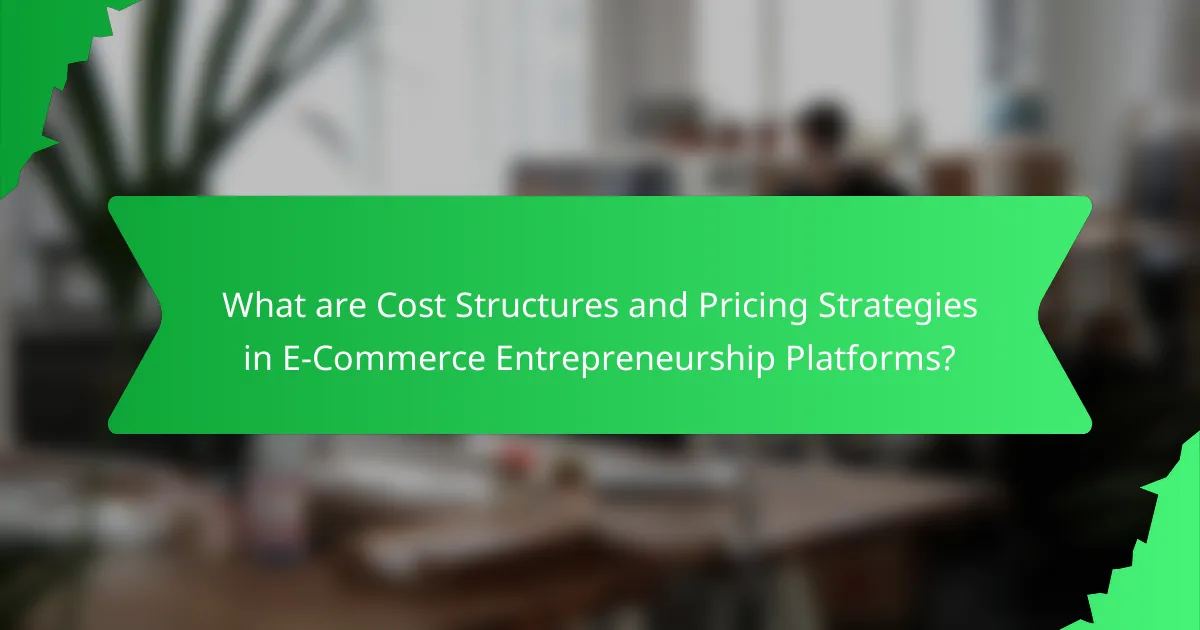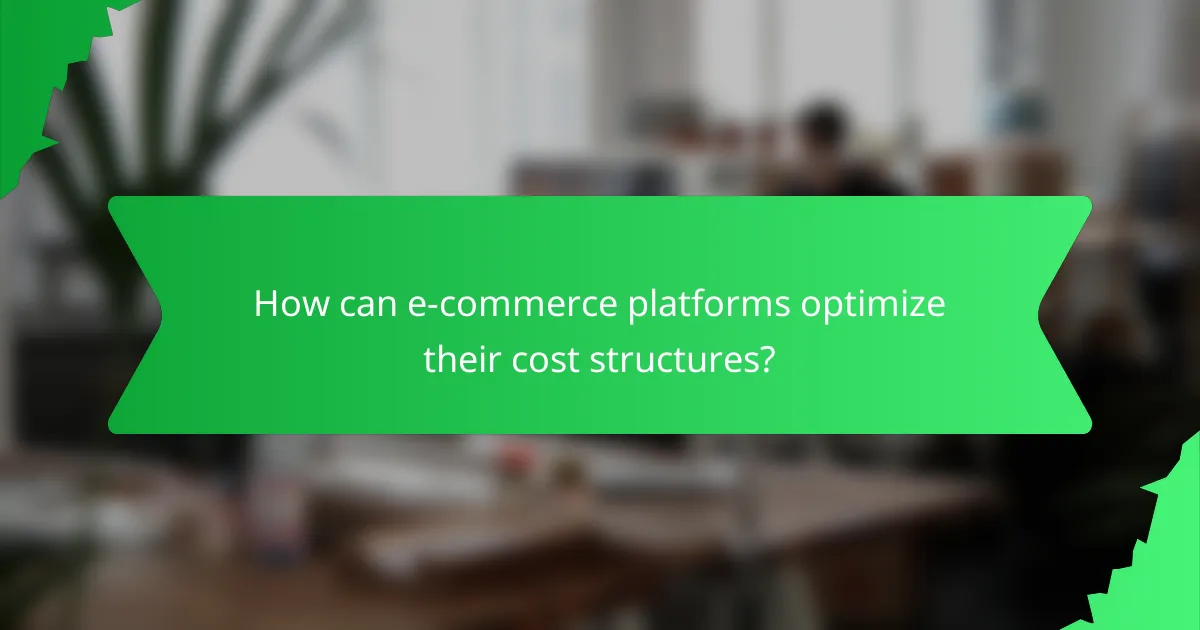Cost structures in e-commerce entrepreneurship platforms encompass the various expenses associated with running an online business, including fixed costs like website hosting and variable costs such as transaction fees and shipping expenses. Pricing strategies, which include cost-plus pricing, value-based pricing, and dynamic pricing, are essential for maximizing revenue and competitiveness. Effective management of cost structures through optimized supply chain practices and data analytics can significantly reduce operational costs, while strategic pricing can enhance customer satisfaction and loyalty. Research indicates that businesses that implement structured pricing strategies can see a notable increase in profitability, underscoring the importance of understanding both cost structures and pricing mechanisms in the e-commerce landscape.

What are Cost Structures and Pricing Strategies in E-Commerce Entrepreneurship Platforms?
Cost structures in e-commerce entrepreneurship platforms refer to the various expenses incurred in operating a business. These include fixed costs, such as website hosting and software subscriptions, and variable costs, like transaction fees and shipping expenses. Pricing strategies, on the other hand, determine how products are priced to maximize revenue and competitiveness. Common strategies include cost-plus pricing, value-based pricing, and dynamic pricing.
For instance, cost-plus pricing adds a markup to the total cost of goods sold. Value-based pricing sets prices based on perceived customer value. Dynamic pricing adjusts prices based on market demand and competitor pricing.
Research indicates that effective pricing strategies can significantly impact profitability. A study published in the Journal of Business Research found that e-commerce businesses using value-based pricing achieved higher customer satisfaction and loyalty. Thus, understanding cost structures and implementing effective pricing strategies are crucial for success in e-commerce.
How do cost structures impact e-commerce entrepreneurship?
Cost structures significantly impact e-commerce entrepreneurship by determining pricing strategies and profitability. A well-defined cost structure helps entrepreneurs identify fixed and variable costs. Fixed costs include expenses like website hosting and software subscriptions. Variable costs often consist of shipping and inventory expenses. Understanding these costs allows entrepreneurs to set competitive prices. Competitive pricing can attract more customers and increase sales volume. In fact, a study by McKinsey & Company found that optimizing cost structures can boost e-commerce profitability by up to 30%. Thus, effective management of cost structures is essential for sustainable growth in e-commerce.
What are the key components of cost structures in e-commerce?
The key components of cost structures in e-commerce include fixed costs, variable costs, and semi-variable costs. Fixed costs remain constant regardless of sales volume. Examples include website hosting, salaries, and rent. Variable costs fluctuate with sales volume. These include shipping fees, payment processing fees, and inventory costs. Semi-variable costs have both fixed and variable elements, such as utility bills that change with usage. Understanding these components helps e-commerce businesses manage expenses effectively. Accurate cost structure analysis supports pricing strategies and profitability assessments.
How do fixed and variable costs differ in e-commerce platforms?
Fixed costs in e-commerce platforms remain constant regardless of sales volume. Examples include website hosting fees and software subscriptions. These costs do not fluctuate with the number of transactions.
Variable costs, on the other hand, change with sales volume. They include expenses such as payment processing fees and shipping costs. As sales increase, variable costs rise proportionately.
Understanding this difference is crucial for budgeting and pricing strategies in e-commerce. Businesses must manage fixed costs to maintain profitability, while also accounting for variable costs that can affect margins.
What pricing strategies are commonly used in e-commerce?
Common pricing strategies used in e-commerce include dynamic pricing, [censured] pricing, and value-based pricing. Dynamic pricing adjusts prices in real-time based on demand and competition. For example, airlines and ride-sharing services often employ this strategy. [censured] pricing sets low initial prices to attract customers and gain market share. This approach is frequently used by new entrants in competitive markets. Value-based pricing determines prices based on perceived customer value rather than costs. Companies like Apple utilize this strategy to position their products as premium offerings. These strategies help e-commerce businesses optimize sales and profitability.
How do [censured] pricing and skimming pricing work?
[censured] pricing involves setting a low initial price to attract customers and gain market share quickly. This strategy encourages trial and adoption among price-sensitive consumers. Over time, the price may be increased once a customer base is established. Companies often use this approach to deter competitors from entering the market.
Skimming pricing, on the other hand, starts with a high price to maximize profits from early adopters. This strategy targets consumers willing to pay more for new products. As demand decreases, the price is gradually lowered to attract additional segments. This method is common in technology markets where innovation is rapid.
Both strategies aim to optimize revenue based on market conditions and consumer behavior. [censured] pricing focuses on volume, while skimming pricing emphasizes profit margins initially.
What role does competitive pricing play in e-commerce success?
Competitive pricing is crucial for e-commerce success as it directly influences consumer purchasing decisions. It helps attract price-sensitive customers who compare prices across platforms. Research indicates that 70% of online shoppers prioritize price when making a purchase. Competitive pricing can also enhance market share by positioning a business favorably against competitors. Additionally, it encourages repeat purchases and customer loyalty, as consumers tend to return to brands that offer consistent value. A study by McKinsey found that optimizing pricing strategies can lead to a 2-5% increase in revenue. Thus, effective competitive pricing is a key factor in driving e-commerce growth and profitability.

How can e-commerce platforms optimize their cost structures?
E-commerce platforms can optimize their cost structures by implementing efficient supply chain management. Streamlining logistics reduces shipping costs and delivery times. Automating inventory management minimizes excess stock and associated holding costs. Utilizing data analytics allows for better demand forecasting, leading to reduced wastage. Negotiating better rates with suppliers can lower procurement costs significantly. Adopting cloud-based solutions can decrease IT infrastructure expenses. Implementing a multi-channel approach can enhance sales without proportional increases in costs. According to a study by McKinsey, optimizing supply chains can result in a 15-20% reduction in operational costs.
What methods can be used to analyze cost structures?
Cost structures can be analyzed using several methods. Common methods include activity-based costing, which allocates costs based on activities that drive costs. Another method is standard costing, which compares actual costs to standard costs to identify variances. Variance analysis is also used to examine differences between expected and actual costs. Financial modeling can help project future costs based on historical data. Benchmarking against industry standards provides insights into cost efficiency. Additionally, break-even analysis determines the sales volume needed to cover costs. Each method offers unique insights into cost management and decision-making.
How do cost-benefit analyses contribute to better pricing strategies?
Cost-benefit analyses enhance pricing strategies by providing a systematic evaluation of costs versus expected benefits. They enable businesses to identify the optimal price point that maximizes profitability. By analyzing various pricing scenarios, companies can determine which options yield the highest net benefits. This analysis helps in understanding customer willingness to pay and the perceived value of products. For instance, a study by the Harvard Business Review found that firms using cost-benefit analyses improved their pricing decisions by 15% on average. This approach also allows for adjustments based on market feedback and competitor pricing. Consequently, cost-benefit analyses lead to more informed and strategic pricing decisions.
What tools are available for tracking and managing costs?
Tools available for tracking and managing costs include accounting software, budgeting tools, and expense management applications. Popular accounting software options are QuickBooks and Xero. These programs provide real-time financial reporting and expense tracking. Budgeting tools like Mint and YNAB help users create and manage budgets effectively. Expense management applications such as Expensify streamline the process of tracking and reporting expenses. These tools often integrate with banking systems for automated tracking. According to a 2021 report by Capterra, 70% of small businesses use financial software to manage costs efficiently.
What are the implications of pricing strategies on customer behavior?
Pricing strategies significantly influence customer behavior. Different pricing approaches can alter perceptions of value and affordability. For instance, premium pricing can create a perception of higher quality. Conversely, discount pricing may attract price-sensitive customers. Research indicates that psychological pricing, such as setting prices just below a round number, can increase sales. A study by Thomas and Morwitz (2005) found that consumers are more likely to purchase products priced at $19.99 than at $20.00. Additionally, bundling products can encourage customers to buy more than they initially intended. Overall, effective pricing strategies can drive customer engagement and purchasing decisions.
How do perceived value and pricing influence purchasing decisions?
Perceived value and pricing significantly influence purchasing decisions. Consumers often equate higher prices with better quality. This perception can lead to increased demand for premium-priced products. Research shows that 70% of consumers consider price as a key factor in their purchasing decisions. Additionally, perceived value can enhance customer loyalty. When customers believe they receive value for their money, they are more likely to return. Brands that effectively communicate their value proposition often see higher conversion rates. Price promotions can also temporarily boost sales by altering perceived value. Overall, the interplay between perceived value and pricing shapes consumer behavior in e-commerce.
What psychological pricing tactics can enhance sales?
Psychological pricing tactics can significantly enhance sales by influencing consumer perception. One effective tactic is charm pricing, which involves pricing items just below a round number, such as $9.99 instead of $10. This creates the perception of a better deal. Research shows that consumers tend to focus on the leftmost digit, making $9.99 appear substantially cheaper. Another tactic is price anchoring, where a higher reference price is presented alongside a lower sale price. This makes the sale price seem more attractive. Additionally, offering tiered pricing can enhance perceived value. When multiple price options are available, consumers often choose a middle option, boosting overall sales. These tactics leverage consumer psychology, leading to increased purchasing behavior.

What are the best practices for implementing cost structures and pricing strategies?
Best practices for implementing cost structures and pricing strategies include conducting thorough market research. Understanding competitors’ pricing helps identify industry benchmarks. Businesses should analyze their own cost structures to determine fixed and variable costs. This analysis aids in setting competitive yet profitable pricing. Utilizing dynamic pricing models can adjust prices based on demand fluctuations. Implementing tiered pricing can cater to different customer segments effectively. Regularly reviewing and adjusting pricing strategies ensures alignment with market conditions. According to a study by McKinsey, companies that adopt structured pricing strategies can increase profits by up to 20%.
How can e-commerce entrepreneurs create effective pricing models?
E-commerce entrepreneurs can create effective pricing models by analyzing costs, market demand, and competitor pricing. First, they should identify all costs associated with their products, including production, shipping, and overhead. Next, understanding customer willingness to pay is crucial. Entrepreneurs can conduct surveys or analyze sales data to gauge demand.
Additionally, studying competitors helps in setting competitive prices. Entrepreneurs should consider pricing strategies such as cost-plus pricing, value-based pricing, or dynamic pricing. Each strategy has its advantages depending on the market context. For instance, value-based pricing can maximize profits when unique products are offered.
Finally, testing and adjusting prices based on customer feedback and sales performance is essential. Regularly reviewing and refining pricing models ensures they remain effective and aligned with market changes.
What factors should be considered when setting prices for products?
When setting prices for products, several factors must be considered. First, production costs should be analyzed. This includes materials, labor, and overhead expenses. Second, market demand plays a crucial role. Higher demand may allow for higher pricing. Third, competitor pricing needs evaluation. Understanding competitors’ prices helps position the product effectively. Fourth, target audience income levels should be assessed. This influences what customers are willing to pay. Additionally, perceived value is important. Customers often pay more for products they view as high quality. Lastly, economic conditions can affect pricing strategies. Inflation or recession may necessitate adjustments in pricing. Each of these factors contributes to a comprehensive pricing strategy.
How can businesses adapt pricing strategies based on market trends?
Businesses can adapt pricing strategies based on market trends by analyzing consumer behavior and competitor pricing. They should regularly monitor market conditions to identify shifts in demand. Utilizing data analytics can help businesses understand pricing elasticity. This allows them to adjust prices dynamically in response to market changes. Implementing tiered pricing models can cater to different customer segments effectively. Moreover, businesses can experiment with promotional pricing during peak seasons to boost sales. Evidence shows that companies using data-driven pricing strategies see a 5-10% increase in revenue. Adapting to market trends ensures competitive advantage and enhances profitability.
What common challenges do e-commerce platforms face in pricing?
E-commerce platforms face several common challenges in pricing. One challenge is competition-based pricing. Many platforms struggle to set prices that remain competitive while ensuring profitability. Another challenge is dynamic pricing. Adjusting prices in real-time based on market demand can be complex. Additionally, e-commerce platforms often encounter customer perception issues. Customers may perceive prices as unfair or untrustworthy if they fluctuate frequently.
Cost management is another significant challenge. Platforms must accurately account for shipping, handling, and overhead costs to avoid losses. Furthermore, legal and regulatory compliance can complicate pricing strategies. Different regions may have varying regulations that affect pricing structures.
Finally, data analysis is essential but challenging. Platforms need robust analytics to understand pricing impacts on sales and customer behavior. Without proper insights, pricing decisions may not align with market trends.
How can entrepreneurs overcome pricing strategy pitfalls?
Entrepreneurs can overcome pricing strategy pitfalls by conducting thorough market research. Understanding competitors’ pricing helps identify appropriate price points. Utilizing customer feedback can reveal perceived value and willingness to pay. Implementing dynamic pricing allows adjustments based on demand fluctuations. Establishing clear value propositions differentiates products from competitors. Regularly reviewing pricing strategies ensures alignment with business goals. Data analytics can inform pricing decisions based on sales performance. These methods have been shown to improve overall pricing effectiveness in various industries.
What are the signs of an ineffective pricing strategy?
Signs of an ineffective pricing strategy include declining sales volume and reduced market share. When prices do not align with customer expectations, sales may drop. Competitors may offer better value, leading to customer loss. Additionally, profit margins may shrink if prices are set too low. If customer feedback indicates dissatisfaction with pricing, it signals a misalignment. Frequent price changes can confuse customers, reflecting poor strategy. Lastly, a lack of clear pricing objectives can lead to inconsistent pricing decisions. These indicators highlight the need for a reassessment of pricing strategies.
What tips can help e-commerce entrepreneurs successfully implement cost structures and pricing strategies?
E-commerce entrepreneurs can successfully implement cost structures and pricing strategies by analyzing their expenses meticulously. Understanding fixed and variable costs is crucial. Fixed costs remain constant regardless of sales, while variable costs fluctuate with sales volume.
Conducting market research helps entrepreneurs set competitive prices. This research should include analyzing competitors’ pricing and customer expectations.
Utilizing pricing models like cost-plus pricing or value-based pricing can also be effective. Cost-plus pricing adds a markup to costs, ensuring profitability. Value-based pricing sets prices based on perceived value to customers.
Regularly reviewing and adjusting pricing strategies is essential. Market conditions and consumer behavior can change, necessitating price adjustments.
Implementing software tools for cost tracking can enhance accuracy. These tools provide real-time insights into expenses and profits.
Finally, testing different pricing strategies through A/B testing can inform better decisions. This method allows entrepreneurs to see which prices yield the best results.
Cost structures and pricing strategies are critical components for e-commerce entrepreneurship platforms, encompassing fixed and variable costs that impact overall profitability. This article explores the various elements of cost structures, including examples of fixed costs like website hosting and variable costs such as shipping fees. It also examines common pricing strategies, such as cost-plus, value-based, and dynamic pricing, highlighting their effects on consumer behavior and market competitiveness. Additionally, the article discusses methods for optimizing cost structures and adapting pricing strategies based on market trends, providing actionable insights for e-commerce entrepreneurs seeking to enhance their business performance.
